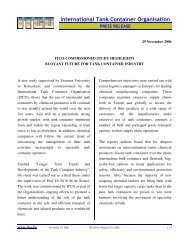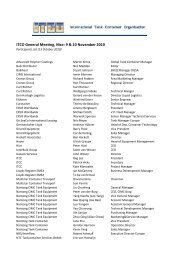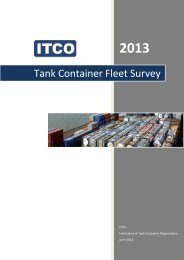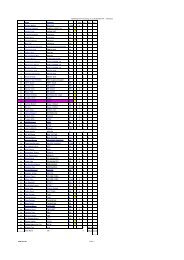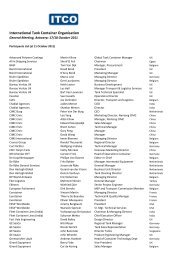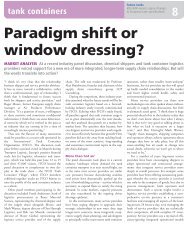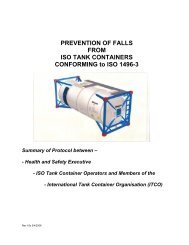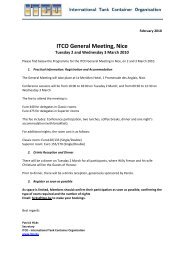You also want an ePaper? Increase the reach of your titles
YUMPU automatically turns print PDFs into web optimized ePapers that Google loves.
ICHCA International <strong>Safe</strong>ty Panel Briefing Pamphlet No 30<br />
A2.2.11 The degree <strong>of</strong> filling should be filled in the appropriate box on the Dangerous<br />
or Non Regulated Goods Note (see Annex 4, figure A4.2 and figure A4.3<br />
Note: <strong>Tank</strong> containers shall not be <strong>of</strong>fered for transport:<br />
with a degree <strong>of</strong> filling, for liquids having a viscosity <strong>of</strong> less than 2,680<br />
mm 2 /s at 20 ° C, or,<br />
at the maximum temperature <strong>of</strong> the substance during transport in the<br />
case <strong>of</strong> a heated substance, <strong>of</strong> more than 20% but less than 80%<br />
unless the shells <strong>of</strong> portable tanks are divided, by partitions or surge<br />
plates, into sections <strong>of</strong> not more than 7,500 litre capacity;<br />
A2.2.12 Minimum Degrees <strong>of</strong> Filling - Worked Example<br />
Example: A substance, non-viscous, is a dangerous good. It has a liquid<br />
density <strong>of</strong> 1.51 at 20 º C. It is loaded at ambient temperature. A<br />
shipper wishes to ship 20,000 kg consignments in tank<br />
containers. The only suitable tank containers do not have<br />
baffles. What capacity <strong>of</strong> tank should be chosen from a selection<br />
<strong>of</strong> tank containers with capacities 15,000 litres, 17,000 litres or<br />
20,000 litres to carry the substance?<br />
Step one: Calculate the volume (in litres) <strong>of</strong> the substance the shipper<br />
intends to load at the filling temperature:<br />
Cargo Net Mass<br />
Liquid Density<br />
20,000 kg<br />
1.51<br />
= Volume (litres)<br />
= 13,245 litres<br />
Step two: The maximum size <strong>of</strong> an un-baffled tank which can be used to<br />
carry this non-viscous substance is calculated by:<br />
Volume (litres) x 100<br />
80<br />
13,245 x 100<br />
80<br />
= Theoretical tank size<br />
= 16,556 litres<br />
If a tank container without baffles is selected with a greater<br />
capacity than 16,556 litres, it will be less than 80% full for this<br />
particular substance.<br />
Solution: From the available ISO tank containers the 15,000 litre one must<br />
be used.<br />
Page 49 ©ICHCA International Limited



